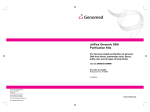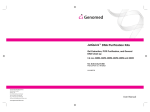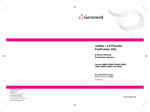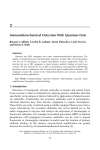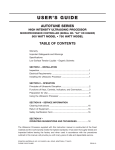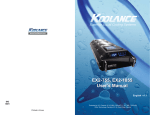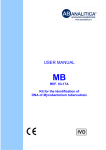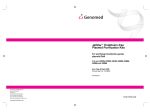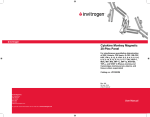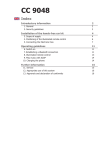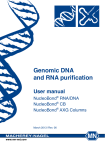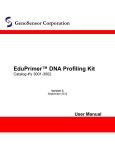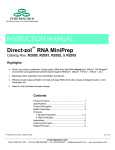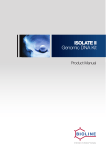Download CST Genomic DNA Purification Kits -- Tissues
Transcript
Genomed JetQuick ® Genomic DNA Purification Kits For purification of genomic DNA from blood, mammalian cells, tissue, swabs, fixed tissue, buffy coat, body fluids, bacteria, and yeast Catalog nos. 440050, 440250, 441020, 441050, 442020, 442050, 450050, 450250 Rev. Date: 12 Aug 2010 Manual Part no.: 70-15016 MAN0001742 Corporate Headquarters Genomed GmbH Poststr. 22 D-32584 Löhne, Germany Tel:+49-(0)5732-904700 Fax:+49-(0)5732-9047010 [email protected] www.genomed-dna.com User Manual ii Contents Kit Contents and Storage ................................................................................ iv Introduction.................................................................................. 1 System Overview .............................................................................................. 1 Experimental Outline ....................................................................................... 3 Methods ........................................................................................ 4 General Information ......................................................................................... 4 Purifying gDNA from Blood and Body Fluids Using Centrifugation ..... 8 Purifying gDNA from Blood and Body Fluids Using Vacuum .............. 17 Purifying gDNA from Mammalian Cells.................................................... 22 Purifying gDNA from Tissue........................................................................ 28 Purifying gDNA from Swabs........................................................................ 32 Purifying gDNA from Paraffin Embedded Tissue.................................... 36 Purifying gDNA from Bacteria ..................................................................... 41 Purifying gDNA from Yeast.......................................................................... 47 Examples of Expected Results ...................................................................... 52 Troubleshooting .............................................................................................. 54 Appendix .................................................................................... 57 Accessory Products......................................................................................... 57 Technical Support ........................................................................................... 58 Purchaser Notification.................................................................................... 59 iii Kit Contents and Storage Types of Kits This manual is supplied with the following products. Product Quantity Cat. no. 50 preps 440 050 250 preps 440 250 20 preps 441 020 50 preps 441 050 JetQuick Blood & Cell Culture DNA Maxiprep Kit 20 preps 442 020 50 preps 442 050 JetQuick® Tissue DNA Miniprep Kit 50 preps 450 050 250 preps 450 250 ® JetQuick Blood & Cell Culture DNA Miniprep Kit ® JetQuick Blood & Cell Culture DNA Midiprep Kit ® Intended Use For research use only. Not intended for any human or animal diagnostic or therapeutic uses. Shipping and Storage Each kit is shipped at room temperature. Upon receipt, store all components at room temperature. Note: Genomed Protease, Proteinase K, and RNase A are stable when stored at room temperature. However, for optimal enzymatic performance, store the enzymes at 4°C upon arrival. For long-term storage, store Genomed Protease, Proteinase K, and RNase A at −20ºC. Continued on next page iv Kit Contents and Storage, Continued JetQuick® Blood & Cell Culture DNA Kits Item The components supplied in the JetQuick® Blood & Cell Culture DNA Kits are listed below. Store all components at room temperature. Miniprep Midiprep Maxiprep 50 preps 250 preps 20 preps 50 preps 20 preps 50 preps 440 050 440 250 441 020 441 050 442 020 442 050 Buffer K1 11 mL 55 mL 66 mL 165 mL 220 mL 550 mL Buffer K2 10 mL 42.5 mL 68.5 mL 171 mL 68.5 mL 171 mL Buffer KX 12 mL 61 mL 95 mL 228 mL 99 mL 243 mL 10 mM TrisHCl, pH 8.5 22 mL 110 mL 35 mL 88 mL 44 mL 110 mL RNase A (20 mg/mL) 650 μL 3 mL 3 mL 2 × 3 mL 3 × 3 mL Genomed Protease (lyophilized powder) 22 mg 5 × 22 mg 5 × 26 mg 320 mg 220 mg 560 mg JetQuick® Spin Columns 50 each 250 each 20 each 50 each 20 each 50 each JetQuick® Receiver Tubes (2.0 mL) 50 each 250 each none none none none 5 × 3.2 mL Continued on next page v Kit Contents and Storage, Continued JetQuick® Tissue DNA Miniprep Kits The components supplied in the JetQuick® Tissue DNA Miniprep Kits are listed below. Store all components at room temperature. Reagents 50 preps 450 050 450 250 Buffer T1 11 mL 55 mL Buffer T2 11 mL 55 mL Buffer T3 10 mL 42 mL Buffer TX 12. mL 60 mL 10 mM Tris-HCl, pH 8.5 22 mL 110 mL RNase A (20 mg/mL) 1.5 mL 2 × 3 mL Proteinase K (lyophilized powder) 26 mg 5 × 26 mg ® 50 each 250 each ® 50 each 250 each JetQuick Spin Columns JetQuick Receiver Tubes (2.0 mL) vi 250 preps Introduction System Overview Introduction JetQuick® Genomic DNA Purification Kits allow rapid and efficient purification of genomic DNA (gDNA). The kits are designed to efficiently isolate genomic DNA from a variety of samples including blood, mammalian cells and tissues, body fluid (e.g., amniotic fluid, saliva, sperm, lymph), mouse/rat tail, swabs, bacteria, yeast, and fixed tissue. The isolated DNA is 20–50 kb in size and is suitable for PCR, restriction enzyme digestion, and Southern blotting. How it Works JetQuick® spin columns contain silica membranes that bind nucleic acids within columns under defined conditions. Using this system, purify DNA in the following manner: 1. Lyse nuclei and denature proteins (e.g., nucleases, histones) in the presence of a cell lysis buffer. 2. Digest denatured proteins into smaller fragments and strip genomic DNA of all bound proteins with protease. 3. Remove residual RNA by digestion with RNase A prior to sample binding to the silica membrane. 4. Bind DNA to the membrane in the column in the presence of chaotropic salts. Remove impurities by thorough washing with Wash Buffers. 5. Elute gDNA in 10 mM Tris-HCl, pH 8.5. Continued on next page 1 System Overview, Continued Advantages System Specifications The advantages of using JetQuick® Genomic DNA Purification Kits are: • Rapid and efficient purification of high-quality genomic DNA from a variety of samples such as mammalian cells and tissue, blood samples, any type of body fluid (e.g., amniotic fluid, saliva, sperm, lymph), mouse tails, swabs, bacteria, yeast, and fixed tissue • Simple lysis of cells and tissues with Proteinase K or Genomed Protease without the need for any mechanical lysis • Minimal contamination from RNA • Reliable performance of the purified DNA in PCR, restriction enzyme digestion, and Southern blotting The table below lists the specifications for JetQuick® Genomic DNA Purification Kits. Kit Type 2 Blood Tissue Kit Size Miniprep Midiprep Maxiprep Miniprep Starting Material 200–1,000 μL whole blood 1–5 mL whole blood 5–20 mL whole blood varies Binding Capacity 50 μg 150 μg 600 μg 50 μg Column Reservoir Capacity 800 μL 15 mL 15 mL 800 μL Elution Volume 25–200 μL 500–800 μL 1–4 mL 25–200 μL DNA Yield 85–95% 85–95% 85–95% 85–95% DNA Size up to 50 kb up to 50 kb up to 50 kb up to 50 kb Experimental Outline Introduction The figure below illustrates the basic steps necessary to use JetQuick® gDNA Purification Kits. For a more detailed overview of blood gDNA purification, refer to page 9 (Purifying gDNA from Blood and Body Fluids Using Centrifugation), or page 17 (Purifying gDNA from Blood and Body Fluids Using Vacuum). Prepare Lysate using Buffer, Protease, and RNase A Add Ethanol to the Lysate Apply sample to Spin Column SPIN Wash column SPIN Repeat Wash Step SPIN Elute DNA with 10 mM Tris-HCl, pH 8.5 3 Methods MEND ION AT RECOM General Information Follow the recommendations below to obtain the best results: • Maintain a sterile environment when handling DNA to avoid any contamination from DNases and ensure that no DNases are introduced into the sterile solutions of the kit • Make sure all equipment that comes in contact with DNA is sterile, including pipette tips and microcentrifuge tubes • Do not vortex the samples for more than 5–10 seconds at each vortexing step to avoid extensive shearing of DNA • To minimize DNA degradation, perform lysate preparation steps quickly, and avoid repeated freezing and thawing of DNA samples • Perform all centrifugation steps at room temperature • Review Elution Parameters on pages 6–7 to determine the suitable elution volume for your requirements • Perform a 5 minute incubation step with 10 mM Tris-HCl, pH 8.5 • If you are using water for elution, use sterile water, pH 7.0–8.5 Continued on next page 4 General Information, Continued Before Starting Safety Information • Reconstitute Buffers KX and K2 (JetQuick® Blood & Cell Culture DNA Kits) or TX and T3 (JetQuick® Tissue DNA Miniprep Kits) with absolute ethanol as directed on the labels of the bottles. Mix well. Mark on each label that ethanol is added. Store the wash buffers with ethanol at room temperature. • Resuspend Genomed Protease (JetQuick® Blood & Cell Culture DNA Kits) or Proteinase K (JetQuick® Tissue DNA Miniprep Kits) in double-distilled or Milli-Q®grade water to a final concentration of 20 mg/mL. Store the reconstituted enzymes in single-use aliquots at −20ºC. Avoid repeated freezing and thawing. • Handle all blood and tissue samples in compliance with established institutional guidelines and take the appropriate precautions (wear a laboratory coat, disposable gloves, and eye protection) when handling blood and tissue samples. Since safety requirements for use and handling of blood and tissue samples may vary at individual institutions, consult the health and safety guidelines and/or officers at your institution. • When processing blood and tissue samples, the eluates collected during wash steps contain biohazardous waste. Dispose the eluate and collection tubes/plates appropriately as biohazardous waste. • Buffers K1, KX, T2, and TX contain guanidine hydrochloride. Always wear a laboratory coat, disposable gloves, and eye protection when handling buffers. Do not add bleach or acidic solutions directly to solutions containing guanidine hydrochloride or sample preparation waste as it forms reactive compounds and toxic gases when mixed with bleach or acids. Continued on next page ® Milli-Q is a registered trademark of Millipore Corporation 5 General Information, Continued RNase A Digestion Centrifugation Elution Parameters • RNA contamination inflates the nucleic acid content measured at 260 nm. • RNase A digestion is performed during sample preparation to degrade RNA present in the sample and minimize RNA contamination in the purified DNA sample. • RNase A is supplied with the kit and an optional RNase A digestion step is included during sample preparation protocols. • If RNA content of the sample is minimal (e.g., mouse tail) and RNA contamination does not interfere with any downstream applications of the purified DNA, you may omit the RNase A digestion step during sample preparation. • Centrifuge Miniprep samples in a microcentrifuge. • Centrifuge Midiprep and Maxiprep samples in a centrifuge with a swing-out rotor. Elution Buffer gDNA is eluted using 10 mM Tris-HCl, pH 8.5 (supplied with the kit). Alternatively, sterile water or TE can be used. Elution Buffer Volume For increased DNA yield, use a higher volume of elution buffer. For increased DNA concentration, use a lower volume of elution buffer. Continued on next page 6 General Information, Continued Number of Elutions The absolute DNA yield can be increased by performing a second elution step. Use the same volume of buffer for both elution steps. To prevent dilution of the gDNA sample and to avoid contact of the spin column with the eluate, perform the two-elution steps using different tubes. Prep Size Volume of First Elution DNA in 1st eluate DNA in 2nd eluate Miniprep 50 μL 80% 20% 100 μL 90% 10% 0.3 mL 41% 59% 0.5 mL 60% 40% 0.8 mL 75% 25% 1.0 mL 83% 17% 1 mL 80% 20% 2 mL 87% 13% 3 mL 92% 8% 4 mL 93% 7% Midiprep Maxiprep 7 Purifying gDNA from Blood and Body Fluids Using Centrifugation Introduction The JetQuick® Blood & Cell Culture DNA Mini, Midi, and Maxiprep Kits are designed to purify gDNA from any type of body fluid (e.g., amniotic fluid, saliva, sperm, lymph) and fresh or frozen whole blood, which may be collected in the presence of anti-coagulants such as EDTA or citrate. To obtain highquality genomic DNA, follow the guidelines recommended on page 4. For a procedure using Vacuum manifold, see page 17. Materials Needed • 96–100% ethanol • Sample for DNA isolation (see page 10) • Sterile, DNase-free microcentrifuge tubes (Miniprep only) • Sterile, DNase-free 50 mL tubes (Midiprep and Maxiprep) • Water baths or heat blocks • Microcentrifuge capable of centrifuging >12,000 × g • Centrifuge with a swing-out rotor, capable of centrifuging 2,000–5,000 × g (Midiprep and Maxiprep only) • Optional: Phosphate Buffered Saline (PBS, see page 57) or equivalent standard saline buffer for processing 1 mL Miniprep, 20 mL Maxiprep, or buffy coat samples • Optional: White Blood Cell Buffer (see page 11) for processing 1 mL Miniprep or 20 mL Maxiprep samples Components supplied with the JetQuick® Blood & Cell Culture DNA Mini, Midi, and Maxiprep Kits • Buffers K1, K2, and KX • Genomed Protease, lyophilized powder, see page 5 • RNase A (20 mg/mL) • 10 mM Tris-HCl, pH 8.5 • JetQuick® Spin Columns • JetQuick® Receiver Tubes (Miniprep Kits only) Continued on next page 8 Purifying gDNA from Blood and Body Fluids Using Centrifugation, Continued Experimental Outline The figure below illustrates the basic steps necessary to purify gDNA using centrifugation with the JetQuick® Blood & Cell Culture DNA Purification Kits. n Prepare lysate with Genomed Protease and RNase A Prepare lysate with Genomed Protease and RNase A Add 3 mL ethanol to the lysate Apply sample to a TM JetQuick Spin Column Elute with Tris-HCl, pH 8.5 Prepare lysate with Genomed Protease and RNase A Add 10 mL ethanol to the lysate Apply sample to a TM JetQuick Spin Column Apply sample to a TM JetQuick Spin Column Wash the column with 10 mL Buffer KX Wash the column with 10 mL Buffer KX Wash the column with 10 mL Buffer K2 Wash the column with 10 mL Buffer K2 Elute with Tris-HCl, pH 8.5 Elute with Tris-HCl, pH 8.5 Continued on next page 9 Purifying gDNA from Blood and Body Fluids Using Centrifugation, Continued Sample Volumes The table below lists the appropriate procedure and the relevant page reference based on the starting sample volume. Starting Volume Prep Size Protocol Page no. Up to 200 μL Miniprep Standard, no modification 12 300 μL – 1 mL Miniprep Requires lysate concentration 11 1–5 mL Midiprep Standard, no modification 12 6–10 mL Maxiprep Standard, no modification 12 11–20 mL Maxiprep Requires lysate concentration 11 • Blood from a healthy person contains on average 5 × 106 – 1 × 107 DNA-containing lymphocytes per mL. The values in the table are for nonnucleated blood (e.g., human or mouse). Nucleated starting blood (e.g., bird) volumes will be substantially lower (e.g., 5–10 μL for Miniprep). • Scale up or down the volumes of all buffers and components proportionally if using a non-standard starting volume (e.g., standard starting volumes are 3 mL whole blood for Midiprep and 10 mL for Maxiprep). • For body fluids, you may use the volumes indicated in the table above. However, if the body fluid sample is dilute or has few DNA-containing cells, concentrate the cells by centrifugation (12,000 × g for 30 seconds for Miniprep or 5,000 × g for 2 minutes for a Midiprep or Maxiprep). Following centrifugation, aspirate the supernatant and resuspend the cell pellet in 200 μL (Mini), 3 mL (Midi), or 10 mL (Maxi) PBS. Continued on next page 10 Purifying gDNA from Blood and Body Fluids Using Centrifugation, Continued Buffy Coat Samples Use no more than 1 – 2 ×108 cells per buffy coat preparation. Adjust the volume of buffy coat corresponding to this amount of cells with PBS, TBS or another standard saline buffer (to be provided by the user) to an overall volume of 3 mL (Midiprep) or 10 mL (Maxiprep). Preparing Concentrated Lysates If you are using standard starting blood volumes of up to 200 μL for Miniprep, 1–5 mL for Midiprep, or 6–10 mL for Maxiprep (see page 10), skip this section. To purify gDNA from 300 μL to 1 mL blood samples with the JetQuick® Blood Miniprep Kit or 11 to 20 mL blood samples with the JetQuick® Blood Maxiprep Kit: 1. Prepare WBC Buffer: 10 mM Tris-HCl, pH 8.5 5 mM MgCl2 320 mM Sucrose 1% Triton® X-100 2. Place whole blood sample into a sterile harvesting tube. Starting Materials Miniprep Maxiprep Starting Sample Volume 300 μL – 1 mL 11–20 mL Harvesting Tube Size 2 mL 50 mL 3. Add an equal volume of WBC Buffer to the blood sample. Mix thoroughly by inverting the tube several times. 4. Centrifuge using the following conditions: Centrifugation Miniprep Maxiprep Acceleration 12,000 × g 5,000 × g Duration 30 seconds 2 minutes Continued on next page 11 Purifying gDNA from Blood and Body Fluids Using Centrifugation, Continued Preparing Concentrated Lysates, Continued 5. Aspirate the supernatant with a pipette. Do not disturb the white blood cell pellet which appears light red. 6. Resuspend the cell pellet in PBS or equivalent standard saline buffer. Mix by pulse-vortexing. 7. Preparing Lysate Reagent Miniprep Maxiprep Volume PBS 180 μL 9.5 mL Proceed immediately to Preparing Lysate, below. Prepare lysate from up to 200 μL (Mini), 1 to 5 mL (Midi), and 6 to 10 mL (Maxi) body fluid or blood samples (nucleated or nonnucleated) as described below. See page 10 for alternate starting volumes that require lysate concentration. 1. Set a water bath or heat block at 58°C (for Miniprep) or 70 °C (for Midiprep and Maxiprep). 2. Harvest cells by adding fresh or frozen blood, serum, plasma, or buffy coat to a clean, sterile tube. The table below indicates starting sample volumes. Starting Materials Miniprep Midiprep Maxiprep Starting Sample Volume 200 μL 3 mL 10 mL Harvesting Tube Size 1.5 mL 50 mL 50 mL Continued on next page 12 Purifying gDNA from Blood and Body Fluids Using Centrifugation, Continued Preparing Lysate, Continued 3. Add the reagents in the order listed in the table below and mix thoroughly by vortexing or inverting the tube. Do not add Genomed Protease directly to Buffer K1. First mix the suspended cells with the enzyme, and then add Buffer K1. Reagent / Operation 4. Miniprep Midiprep Maxiprep Genomed Protease 20 μL 300 μL 500 μL RNase A (optional) 10 μL 100 μL 300 μL Mix sample vortex vortex vortex Buffer K1 200 μL 3 mL 10 mL Mix sample vortex vortex vortex Incubate the sample for 10 minutes at the temperature indicated in the table below to degrade protein: Incubation Miniprep Midiprep Maxiprep Temperature 58ºC 70°C 70°C Note: The optimal incubation temperature for Genomed Protease is 58°C. However, to reach the catalytic temperature range as quickly as possible, incubate Midiprep and Maxiprep samples at 70°C. If incubation at 58°C is desired, extend the incubation time to 20 minutes. 5. Add ethanol and mix by vortexing. Reagent Miniprep Midiprep Maxiprep 96–100% Ethanol 200 μL 3 mL 10 mL Note: Mix the sample immediately to prevent precipitation of nucleic acids due to high local alcohol concentrations. 6. Proceed immediately to Purifying DNA, next page. Continued on next page 13 Purifying gDNA from Blood and Body Fluids Using Centrifugation, Continued Purifying DNA 1. Assemble a JetQuick® Spin Column with an appropriate receiver tube: Spin Column Assembly Receiver Tube size Miniprep Midiprep Maxiprep 2 mL, provided in the kit 50 mL 50 mL Note: For 50 mL tubes, loosely attach a cap to allow ventilation during centrifugation. 2. Apply the sample from Step 5, previous page, into the JetQuick® Spin Column. Note: For Maxiprep starting blood volumes >5 mL, load 15 mL blood lysate onto the JetQuick® Maxi-Spin column with two successive rounds of centrifugation. 3. Centrifuge samples using the following conditions: Centrifugation Miniprep Midiprep Maxiprep Acceleration 10,000 × g 2,000 × g 2,000 × g Duration 1 minute 3 minutes 3 minutes 4. Discard the flow-through. 5. Add reconstituted Buffer KX (page 5) to the column. 6. Reagent Miniprep Midiprep Maxiprep Buffer KX 500 μL 10 mL 10 mL Centrifuge using the following conditions: Centrifugation Miniprep Midiprep Maxiprep Acceleration 10,000 × g 5,000 × g 5,000 × g Duration 1 minute 2 minutes 2 minutes Continued on next page 14 Purifying gDNA from Blood and Body Fluids Using Centrifugation, Continued Purifying DNA, Continued 7. Discard the flow-through and reassemble the spin column. 8. Add Buffer K2 prepared with ethanol (page 5) to the column. 9. Reagent Miniprep Midiprep Maxiprep Buffer K2 500 μL 10 mL 10 mL Centrifuge using the conditions described in Step 6. 10. Discard the flow-through and re-assemble the spin column using the same receiver tube. Centrifuge again to clear the silica membrane of any residual liquid. Discard the receiver tube. Centrifugation Miniprep Midiprep Maxiprep Acceleration 12,000 × g 5,000 × g 5,000 × g Duration 1 minute 10 minutes 10 minutes 11. Place the JetQuick® Spin Column into a new, sterile elution tube (not supplied). Spin Column Assembly Elution tube size Miniprep Midiprep Maxiprep 1.5 mL 50 mL 50 mL Continued on next page 15 Purifying gDNA from Blood and Body Fluids Using Centrifugation, Continued Purifying DNA, Continued 12. Add prewarmed (70ºC) 10 mM Tris-HCl, pH 8.5, or water to the column. See Elution Parameters (pages 6–7) to determine the suitable elution volume for your application. Incubate at room temperature for the time specified in the table below. Elution Miniprep Midiprep Maxiprep 10 mM TrisHCl, pH 8.5 25–200 μL 500–800 μL 1–4 mL Incubation Time 2 minutes 5 minutes 5 minutes 13. Centrifuge the column at room temperature to elute the DNA. Centrifugation Miniprep Midiprep Maxiprep Acceleration 10,000 × g 5,000 × g 5,000 × g Time 2 minutes 2 minutes 2 minutes 14. Optional: To recover more DNA, perform a second elution in another sterile tube. Centrifuge the column as directed in Step 13. The tube contains purified DNA. Remove and discard the column. Combine the contents of the elution tubes only if overall yield is of greater importance than maintaining the higher concentration obtained in the first eluate (depending on your application). Storing DNA 16 To avoid repeated freezing and thawing of DNA, • Store the purified DNA at 4°C for immediate use or • Aliquot the DNA and store at −20°C for long-term storage. Purifying gDNA from Blood and Body Fluids Using Vacuum Introduction The procedure for purifying genomic DNA from blood and any type of body fluid (e.g., amniotic fluid, saliva, sperm, lymph) using JetQuick® Blood & Cell Culture DNA Kits with a vacuum manifold is described below. To obtain high-quality genomic DNA, follow the guidelines recommended on page 4. Experimental Outline The figure below illustrates the basic steps necessary to purify gDNA using vacuum with the JetQuick® Blood & Cell Culture DNA Kits. Prepare lysate using Genomed Protease and RNase A Add ethanol to the lysate Apply sample to JetQuickTM Spin Column attached to vacuum manifold Wash column with Buffer KX Wash column with Buffer K2 SPIN Elute DNA with 10 mM Tris-HCl, pH 8.5 Continued on next page 17 Purifying gDNA from Blood and Body Fluids Using Vacuum, Continued Materials Needed • 96–100% ethanol • Sample for DNA isolation (see page 10) • Sterile, DNase-free microcentrifuge tubes • Water baths or heat blocks • Microcentrifuge capable of centrifuging >12,000 × g • Vacuum manifold, see page 57 Components supplied with the JetQuick® Blood & Cell Culture DNA Kits • Buffers K1, K2, and KX Preparing Lysate • Genomed Protease, lyophilized powder, see page 5 • RNase A (20 mg/mL) • 10 mM Tris-HCl, pH 8.5 • JetQuick® Spin Columns • JetQuick® Receiver Tubes Prepare lysate from up to 200 μL (Mini), 1 to 5 mL (Midi), or 6 to 10 mL (Maxi) blood or body fluid samples. See page 10 for detailed starting sample volume information. 1. Set a water bath or heat block at 58°C (Mini) or 70 °C (Midi and Maxi). 2. Harvest cells by adding fresh or frozen blood, body fluid, serum, plasma, or buffy coat to a clean, sterile tube. Starting Materials Miniprep Midiprep Maxiprep Starting Sample Volume 200 μL 3 mL 10 mL Harvesting Tube Size 1.5 mL 50 mL 50 mL Continued on next page 18 Purifying gDNA from Blood and Body Fluids Using Vacuum, Continued Preparing Lysate, Continued 3. Add the reagents in the order listed in the table below and mix thoroughly by vortexing or inverting the tube. Do not add Genomed Protease directly to Buffer K1. First mix the suspended cells with the enzyme, and then add Buffer K1. Reagent / Operation 4. Miniprep Midiprep Maxiprep Genomed Protease 20 μL 300 μL 500 μL RNase A (optional) 10 μL 100 μL 300 μL Mix sample vortex vortex vortex Buffer K1 200 μL 3 mL 10 mL Mix sample vortex vortex vortex Incubate the sample for 10 minutes at the temperature indicated in the table below to degrade protein: Incubation Miniprep Midiprep Maxiprep Temperature 58ºC 70°C 70°C Note: The optimal incubation temperature for Genomed Protease is 58°C. However, to reach the catalytic temperature range as quickly as possible, incubate Midiprep and Maxiprep samples at 70°C. If incubation at 58°C is desired, extend the incubation time to 20 minutes. 5. Add ethanol and mix by vortexing. Reagent Miniprep Midiprep Maxiprep 96–100% Ethanol 200 μL 3 mL 10 mL Note: Mix the sample immediately to prevent precipitation of nucleic acids due to high local alcohol concentrations. 6. Proceed immediately to Purifying DNA (next page). Continued on next page 19 Purifying gDNA from Blood and Body Fluids Using Vacuum, Continued Purifying DNA 1. Attach vacuum manifold (such as the EveryPrep™ Universal Vacuum Manifold, see page 57) to a vacuum source. Attach as many JetQuick® Spin Columns as necessary to the female Luer inlets on the vacuum manifold. 2. Load the blood lysate from Step 6, previous page, into the JetQuick® Spin Columns. 3. Apply vacuum (–200 to –650 mbar) until all liquid is pulled through the column. Turn off the vacuum source. 4. Add reconstituted Buffer KX (page 5) to the column. Reagent Miniprep Midiprep Maxiprep Buffer KX 500 μL 10 mL 10 mL 5. Apply vacuum (–200 to –650 mbar) until all liquid has been pulled through the column. Turn off vacuum source. 6. Add Buffer K2 prepared with ethanol (page 5) to the column and repeat Step 5. Reagent Miniprep Midiprep Maxiprep Buffer K2 500 μL 10 mL 10 mL 7. To remove last traces of ethanol, turn on the vacuum again and pull air through the spin columns on the vacuum manifold until all residual ethanol is removed from the silica membrane. 8. Place the JetQuick® Spin Column into a new, sterile elution tube (not supplied). Spin Column Assembly Elution tube size Miniprep Midiprep Maxiprep 1.5 mL 50 mL 50 mL Continued on next page 20 Purifying gDNA from Blood and Body Fluids Using Vacuum, Continued Purifying DNA, Continued 9. Add prewarmed (70ºC) 10 mM Tris-HCl, pH 8.5, or water to the column. See Elution Parameters (pages 6–7) to determine the suitable elution volume for your application. Incubate at room temperature for the time specified in the table below. Elution Miniprep Midiprep Maxiprep 10 mM TrisHCl, pH 8.5 25–200 μL 500–800 μL 1–4 mL Incubation Time 2 minutes 5 minutes 5 minutes 10. Centrifuge the column at room temperature to elute the DNA. Centrifugation Miniprep Midiprep Maxiprep Acceleration 10,000 × g 5,000 × g 5,000 × g Time 2 minutes 2 minutes 2 minutes The tube contains purified genomic DNA. 11. Optional: To recover more DNA, perform a second elution in another sterile tube. Centrifuge the column as directed in Step 10. The tube contains purified DNA. Remove and discard the column. Combine the contents of the elution tubes only if overall yield is of greater importance than maintaining the higher concentration obtained in the first eluate (depending on your application). Storing DNA To avoid repeated freezing and thawing of DNA, • Store the purified DNA at 4°C for immediate use or • Aliquot the DNA and store at −20°C for long-term storage. 21 Purifying gDNA from Mammalian Cells Introduction The procedure for purifying genomic DNA from mammalian cells using JetQuick® Blood & Cell Culture DNA Mini, Midi, and Maxiprep Kits is described below. To obtain high-quality genomic DNA, follow the guidelines recommended on page 4. Materials Needed • 96–100% ethanol • Sample for DNA isolation (see next page) • Phosphate Buffered Saline (PBS) (page 57) • Sterile, DNase-free microcentrifuge tubes (Miniprep only) • Sterile, DNase-free 50-mL tubes (Midiprep and Maxiprep) • Centrifuge with swing-out rotor (Midiprep and Maxiprep) • Microcentrifuge capable of centrifuging at >12,000 × g • Water baths or heat blocks Components supplied with the JetQuick® Blood & Cell Culture DNA Mini, Midi, and Maxiprep Kits • Buffers K1, K2, and KX • Genomed Protease, lyophilized powder, see Before Starting, page 5 • RNase A (20 mg/mL) • 10 mM Tris-HCl, pH 8.5 • JetQuick® Spin Columns • JetQuick® Receiver Tubes (Miniprep Kits only) Continued on next page 22 Purifying gDNA from Mammalian Cells, Continued Starting Material The table below lists the amount of starting material recommended for each purification kit. Prep Size Preparing Cell Lysate Number of cells Miniprep 5 × 106 to 1 × 107 Midiprep 7.5 × 107 to 1 × 108 Maxiprep 2.5 × 108 to 5 × 108 Prepare lysate from mammalian cells as described below. 1. Set a water bath or heat block at 58°C (Miniprep) or 70°C (Midiprep and Maxiprep). 2. Harvest cells into the appropriate tube (see table below). • For cells grown in a monolayer, remove the growth medium from the culture plate and harvest cells by trypsinization or use a cell scraper according to established protocols. Transfer cells into a harvesting tube (see table below). • For cells grown in suspension, transfer cells into a harvesting tube. Starting Materials Harvesting tube Miniprep Midiprep Maxiprep 1.5 mL 50 mL 50 mL 3. Centrifuge at 300–350 × g for 5 minutes to pellet cells. 4. Remove the growth medium completely, without disturbing the cell pellet, and resuspend the cells in PBS. Reagent Miniprep Midiprep Maxiprep PBS 200 μL 3 mL 10 mL Continued on next page 23 Purifying gDNA from Mammalian Cells, Continued Preparing Cell Lysate, Continued 5. Add the reagents in the order listed in the table below and mix thoroughly by vortexing or inverting the tube. Do not add Genomed Protease directly to Buffer K1. First mix the suspended cells with the enzyme, and then add Buffer K1. Reagent / Operation 6. Miniprep Midiprep Maxiprep Genomed Protease (20 mg/mL) 20 μL 300 μL 500 μL Optional: RNase A (20 mg/mL) 10 μL 100 μL 300 μL Mix sample vortex vortex vortex Buffer K1 200 μL 3 mL 10 mL Mix sample vortex vortex vortex Incubate the sample for 10 minutes to degrade protein: Incubation Miniprep Midiprep Maxiprep Temperature 58ºC 70°C 70°C Note: The optimal incubation temperature for Genomed Protease is 58°C. However, to reach the catalytic temperature range as quickly as possible, incubate Midiprep and Maxiprep samples at 70°C. If incubation at 58°C is desired, extend the incubation time to 20 minutes. 7. Add ethanol and mix well by vortexing. Reagent Miniprep Midiprep Maxiprep 96–100% Ethanol 200 μL 3 mL 10 mL Note: Mix the sample immediately to prevent precipitation of nucleic acids due to high local alcohol concentrations. 8. Proceed immediately to Purifying DNA (next page). Continued on next page 24 Purifying gDNA from Mammalian Cells, Continued Purifying DNA 1. Assemble a JetQuick® Spin Column with an appropriate receiver tube: Spin Column Assembly Miniprep Midiprep Maxiprep Receiver Tube 2 mL 50 mL 50 mL Note: For the Midiprep and Maxiprep, loosely attach the cap to the tube to allow ventilation during the centrifugation. 2. Apply the sample from Step 7, previous page, into the JetQuick® Spin Column. 3. Centrifuge samples using the following conditions: Centrifugation Miniprep Midiprep Maxiprep Acceleration 10,000 × g 2,000 × g 2,000 × g Time 1 minute 3 minutes 3 minutes 4. Discard the flow-through. 5. Add Buffer KX with ethanol (page 5) to the column. 6. 7. Reagent Miniprep Midiprep Maxiprep Buffer KX 500 μL 10 mL 10 mL Centrifuge using the following conditions: Centrifugation Miniprep Midiprep Maxiprep Acceleration 10,000 × g 5,000 × g 5,000 × g Time 1 minute 2 minutes 2 minutes Discard the flow-through and reassemble the spin column. Continued on next page 25 Purifying gDNA from Mammalian Cells, Continued Purifying DNA, Continued 8. 9. Add Buffer K2 reconstituted with ethanol (see page 5) to the column. Reagent Miniprep Midiprep Maxiprep Buffer K2 500 μL 10 mL 10 mL Centrifuge using the conditions described in Step 6. 10. Discard the flow-through and re-assemble the spin column using the same receiver tube. Centrifuge again to clear the silica membrane of any residual liquid. Discard the receiver tube. Centrifugation Miniprep Midiprep Maxiprep Acceleration 12,000 × g 5,000 × g 5,000 × g Time 1 minute 10 minutes 10 minutes 11. Place the JetQuick® Spin Column into a new, sterile elution tube. Spin Column Assembly Elution tube size Miniprep Midiprep Maxiprep 1.5 mL 50 mL 50 mL 12. Add prewarmed (70ºC) 10 mM Tris-HCl, pH 8.5, or prewarmed water to the column. See Elution Parameters (pages 6–7) to determine the suitable elution volume for your application. Incubate at room temperature for the time specified in the table below. Elution Miniprep Midiprep Maxiprep 10 mM TrisHCl, pH 8.5 25–200 μL 500–800 μL 1–4 mL Incubation time 2 minutes 5 minutes 5 minutes Continued on next page 26 Purifying gDNA from Mammalian Cells, Continued Purifying DNA, Continued 13. Centrifuge the column at room temperature to elute the DNA. Centrifugation Miniprep Midiprep Maxiprep Acceleration 10,000 × g 5,000 × g 5,000 × g Time 2 minutes 2 minutes 2 minutes 14. Optional: To recover more DNA, perform a second elution step in another sterile tube. Centrifuge the column as directed in Step 13. The tube contains purified DNA. Remove and discard the column. Combine the contents of the elution tubes only if overall yield is of greater importance than maintaining the higher concentration obtained in the first eluate (depending on your application). Storing DNA To avoid repeated freezing and thawing of DNA, • Store the purified DNA at 4°C for immediate use or • Aliquot the DNA and store at −20°C for long-term storage. 27 Purifying gDNA from Tissue Introduction The procedure for purifying gDNA from mammalian tissues, including mouse tail, using JetQuick® Tissue DNA Miniprep Kits is described below. The protocol was adapted from the method published by Bowtell (see Bowtell, D.L.L. 1987. Rapid isolation of eukaryotic DNA. Anal. Biochem. 162: 463). To obtain high-quality genomic DNA, follow the guidelines recommended on page 4. Materials Needed • 96–100% ethanol • Sample for DNA isolation (see below for recommended starting amount) • Sterile, DNase-free microcentrifuge tubes • Water baths or heat blocks • Microcentrifuge capable of centrifuging >12,000 × g Components supplied with the JetQuick™ Tissue DNA Miniprep Kit • Buffers T1, T2, T3, and TX Starting Material • Proteinase K, lyophilized powder, see page 5 • RNase A (20 mg/mL) • 10 mM Tris-HCl, pH 8.5 • JetQuick® Spin Columns • JetQuick® Receiver Tubes The table below lists the amount of starting material recommended based on tissue type. Tissue Amount Brain, Lung, Heart, Kidney 25–30 mg Liver, Spleen 10–20 mg Mouse Tail 0.8–1.2 cm Continued on next page 28 Purifying gDNA from Tissue, Continued Preparing Tissue Lysate Check Buffer T1 for precipitates. If present, warm the solution briefly at 37°C to dissolve the precipitate. 1. Set one water bath or heat block at 55°C and another at 70°C. 2. Mince the tissue sample with a scalpel or freeze the tissue in liquid nitrogen, and grind it into a fine powder with a mortar and pestle. 3. Add 200 μL Buffer T1 to the minced tissue sample in a 1.5 mL microcentrifuge tube. Mix thoroughly by inverting the tube several times. 4. Add 20 μL Proteinase K (20 mg/mL) to the tube. Mix thoroughly by inverting the tube several times. Note: When processing multiple samples, you may prepare a master Digestion Buffer Mix by pre-mixing 200 μL Buffer T1 and 20 μL Proteinase K for each sample. 5. Incubate at 55°C with occasional vortexing until mixture is clear, indicating complete lysis (1–2 hours). For mouse tails or larger tissue pieces, incubate overnight. 6. To remove any particulate materials, centrifuge the lysate at 10,000 × g for 5 minutes at 4ºC. Transfer clear supernatant to a new, sterile microcentrifuge tube. 7. Optional: Add 20 μL RNase A (20 mg/mL) to the lysate and mix well by brief vortexing. 8. Add 200 μL Buffer T2 and mix well by vortexing. 9. Incubate at 70ºC for 10 minutes. Cool the mixture at room temperature for 1 minute. 10. Add 200 μL 96–100% ethanol to the lysate. Mix immediately and thoroughly by vortexing for 5 seconds. Note: When processing multiple samples, you may prepare a Master Buffer/Ethanol Mix by pre-mixing 200 μL Buffer T2 and 200 μL 96–100% ethanol for each sample. 11. Proceed immediately to Purifying DNA (next page). Continued on next page 29 Purifying gDNA from Tissue, Continued Purifying DNA 1. Assemble a JetQuick® Spin Column with a 2 mL Receiver Tube. Apply the sample from Step 10, previous page, into the JetQuick® Spin Column. Note: Processing too many cells may lead to a high DNA content in the sample, so that DNA may already be partially precipitated. If any precipitated matter is present, co-transfer it into the spin column. 2. Centrifuge the sample for 1 minute at 10,000 × g. 3. Discard the flow-through and re-assemble the JetQuick® Spin Column into the Receiver Tube. 4. Add 500 μL Buffer TX with ethanol (see page 5) to the column. 5. Centrifuge column at room temperature at 10,000 × g for 1 minute. 6. Discard the flow-through and re-assemble the JetQuick® Spin Column. 7. Add 500 μL Buffer T3 with ethanol (page 5) to the column. 8. Centrifuge column at room temperature at 10,000 × g for 1 minute. 9. Discard the flow-through and re-assemble the JetQuick® Spin Column using the same 2 mL Receiver Tube. Centrifuge the column again at 12,000 × g for 1 minute at room temperature to clear the silica membrane of any residual liquid. Discard the 2 mL Receiver Tube. 10. Place the JetQuick® Spin Column into a sterile 1.5-mL microcentrifuge tube. 11. Add 25–200 μL of prewarmed (65 ºC–70ºC) 10 mM TrisHCl, pH 8.5, or prewarmed water to the column. See Elution Parameters (pages 6–7) to determine the suitable elution volume for your application. Note: Make certain that the elution buffer covers the entire membrane. Continued on next page 30 Purifying gDNA from Tissue, Continued Purifying DNA, Continued 12. Incubate at room temperature for 5 minutes. 13. Centrifuge the column at 12,000 × g for 2 minutes at room temperature. The tube contains purified genomic DNA. 14. Optional: To recover more DNA, perform a second elution step in another sterile 1.5 mL microcentrifuge tube. 15. Centrifuge the column at 12,000 × g for 2 minutes at room temperature. The tube contains purified DNA. Remove and discard the column. Combine the contents of the elution tubes only if overall yield is of greater importance than maintaining the higher concentration obtained in the first eluate (depending on your application). Storing DNA To avoid repeated freezing and thawing of DNA, • Store the purified DNA at 4°C for immediate use or • Aliquot the DNA and store at −20°C for long-term storage. 31 Purifying gDNA from Swabs Introduction The procedure for purifying genomic DNA from buccal, nasal, pharyngeal, and vaginal swabs using JetQuick® Blood & Cell Culture DNA Miniprep Kits is described below. To obtain high-quality genomic DNA, follow the guidelines recommended on page 4. Materials Needed • 96–100% ethanol • Swab Sample • Phosphate Buffered Saline (PBS) or equivalent saline buffer (i.e. TBS) (see page 57 for ordering information) • Sterile, DNase-free microcentrifuge tubes • Microcentrifuge capable of centrifuging at >12,000 × g • Water baths or heat blocks Components supplied with the JetQuick® Blood & Cell Culture DNA Miniprep Kit • Buffers K1, K2, and KX • Genomed Protease, lyophilized powder, see Before Starting, page 5 • RNase A (20 mg/mL) • 10 mM Tris-HCl, pH 8.5 • JetQuick® Spin Columns • JetQuick® Receiver Tubes The swab protocol utilizes an increased volume of Buffer K1. Therefore, the standard “50 prep” kit contains sufficient Buffer K1 to process 18 swab samples and the “250 prep” JetQuick® Blood & Cell Culture DNA Miniprep Kit contains sufficient Buffer K1 to process 90 samples. To utilize all other components included in the JetQuick® Blood & Cell Culture DNA Miniprep Kits, purchase additional Buffer K1 separately (see page 57). Continued on next page 32 Purifying gDNA from Swabs, Continued Human Buccal Swab Lysate 1. Collect the buccal swab with a suitable tool, such as a T-swab Kit (Isohelix), Dacron swab (Fitzco), C.E.P. Omni Swab (Whatman), or Cotton swab (Puritan Hardwood Products) according to standard collection procedures. Nasal, pharyngeal, or vaginal swabs can be collected in a similar way. 2. Set a water bath or heat block at 58°C. 3. Place the buccal swab into a capped 2 mL microcentrifuge tube (not provided with the kit). • For C.E.P. Omni swabs, press the stem end toward the swab to eject it into the microcentrifuge tube. • For swabs from other suppliers, snap or cut the swab at the break point. The swab should fit entirely inside the tube so that the cap may close. 4. Add 600 μL of PBS, Tris Buffered Saline (TBS), or equivalent standard saline buffer. Mix by vortexing. 5. Add 20 μL Genomed Protease (20 mg/mL) and 10 μL RNase A (20 mg/mL, optional) to the sample and mix very thoroughly by vortexing or inverting the tube. 6. Add 600 μL Buffer K1 and mix very thoroughly by vortexing or inverting the tube. 7. Incubate at 58ºC for 10 minutes. 8. Add 600 μL of 96–100% ethanol. 9. Mix well by vortexing to obtain a homogenous solution. Note: Mix the sample immediately to prevent the precipitation of nucleic acids due to high local alcohol concentrations. 10. Proceed immediately to Purifying DNA, next page. Continued on next page 33 Purifying gDNA from Swabs, Continued Purifying DNA 1. Assemble a JetQuick® Spin Column with a 2 mL Receiver Tube. Apply 700 μL of the sample from Step 9, previous page, into the JetQuick® Spin Column. 2. Centrifuge the sample for 1 minute at 10,000 × g. 3. Discard the flow-through. Note: Repeat Steps 1–3 until all liquid from Step 9 has been processed over the JetQuick® Spin Column. Squeeze out residual liquid from the swab and discard the swab. 4. Add 500 μL Buffer KX with ethanol (page 5) to the column. 5. Centrifuge the column at room temperature at 10,000 × g for 1 minute. 6. Discard the flow-through and re-assemble the JetQuick® Spin Column. 7. Add 500 μL Buffer K2 with ethanol (page 5) to the column. 8. Centrifuge the column at room temperature at 10,000 × g for 1 minute. 9. Discard the flow-through and re-assemble the JetQuick® Spin Column using the same 2 mL Receiver Tube. Centrifuge the column again at 12,000 × g for 1 minute at room temperature to clear the silica membrane of any residual liquid. Discard the receiver tube. 10. Place the JetQuick® Spin Column into a sterile 1.5 mL microcentrifuge tube. 11. Add 25–200 μL of prewarmed (65 ºC –70ºC) 10 mM TrisHCl, pH 8.5, or prewarmed water to the column. See Elution Parameters (pages 6–7) to determine the suitable elution volume for your application. 12. Incubate at room temperature for 2 minutes. Continued on next page 34 Purifying gDNA from Swabs, Continued Purifying DNA, Continued 13. Centrifuge the column at 10,000 × g for 2 minutes at room temperature. The tube contains purified genomic DNA. 14. Optional: To recover more DNA, perform a second elution step in another sterile 1.5 mL microcentrifuge tube. 15. Centrifuge the column at 10,000 × g for 2 minutes at room temperature. The tube contains purified DNA. Remove and discard the column. Combine the contents of the elution tubes only if overall yield is of greater importance than maintaining the higher concentration obtained in the first eluate (depending on your application). Storing DNA To avoid repeated freezing and thawing of DNA, • Store the purified DNA at 4°C for immediate use or • Aliquot the DNA and store at −20°C for long-term storage 35 Purifying gDNA from Paraffin Embedded Tissue Introduction The procedure for purifying gDNA from fixed tissues using the JetQuick® Tissue DNA Miniprep Kit is described below. The fixative used influences the yield and quality of the purified DNA. Fixatives such as alcohols or formalin are easiest to handle. For tissues fixed with paraffin, a pretreatment of the sample is necessary (see page 37). Fixatives that cause cross-linking (i.e., osmic acid) are not recommended as it can be difficult to obtain amplifiable DNA from tissues fixed with these agents. To obtain high-quality genomic DNA, follow the guidelines recommended on page 4. Materials Needed • Xylene or PBS • 96–100% ethanol • Sample for DNA isolation • Sterile, DNase-free microcentrifuge tubes • Water baths or heat blocks • Microcentrifuge capable of centrifuging >12,000 × g Components supplied with the JetQuick® Tissue DNA Miniprep Kit • Buffers T1, T2, T3, and TX • Proteinase K, lyophilized powder, see Before Starting, page 5 • RNase A (20 mg/mL) • 10 mM Tris-HCl, pH 8.5 • JetQuick® Spin Columns • JetQuick® Receiver Tubes Continued on next page 36 Purifying gDNA from Paraffin Embedded Tissue, Continued An RNase A digestion step is normally not necessary for fixed tissues. Due to the age of the sample and prior treatments most of the RNA is already degraded. Xylene Extraction It may not be necessary to remove the paraffin by xylene extraction before processing. The paraffin melts during the 56°C incubation and does not affect the JetQuick® gDNA purification procedure. However, xylene extraction is necessary for some types of paraffin-embedded samples. You may try omitting the xylene-extraction protocol, since it makes the isolation procedure much simpler. Formalin/ Alcohol Fixed Tissues Wash formalin-/alcohol fixed tissue (up to 30 mg tissue) twice with PBS and proceed immediately to Preparing Fixed Tissue Lysate (page 38). FormalinFixed, ParaffinEmbedded Tissue 1. Set a water bath or heat block at 37°C. 2. Place a small section of FFPE tissue (no more than 30 mg) in a sterile microcentrifuge tube. 3. Add 1.2 mL xylene to the sample and vortex vigorously for a few seconds. Note: Use appropriate precautions while using xylene and dispose of xylene in compliance with established institutional guidelines. CitriSolv™ Clearing Agent (Fisher catalog no. 22-143-975) is a biodegradable alternative to xylene for paraffin extraction. 4. Centrifuge at 12,000 × g for 5 minutes at room temperature. Carefully remove the supernatant without disturbing the pellet. Continued on next page 37 Purifying gDNA from Paraffin Embedded Tissue, Continued FormalinFixed, ParaffinEmbedded Tissue, Continued 5. Add 1.2 mL 96–100% ethanol and vortex gently to remove residual xylene from the tissue pellet. 6. Centrifuge at 12,000 × g for 5 minutes at room temperature. Carefully remove the supernatant. 7. Repeat ethanol extraction (Steps 5–6) once. 8. Incubate the tubes with the lid open at 37ºC for 10 to 15 minutes to evaporate residual ethanol. 9. Proceed immediately to Preparing Fixed Tissue Lysate, below. Before Starting Check Buffer T1 for precipitates. If present, warm the solution briefly at 37°C to dissolve the precipitate. Preparing Fixed Tissue Lysate Following fixative-removal from the tissue sample, prepare the lysate according to the following procedure: 1. Set one water bath or heat block at 56°C and another at 70°C. 2. Add 200 μL Buffer T1 to the tissue sample. Mix thoroughly by inverting the tube several times. 3. Add 20 μL Proteinase K (20 mg/mL). Mix well by inverting the tube several times. Note: When processing multiple samples, you may prepare a master Digestion Buffer Mix by pre-mixing 200 μL Buffer T1 and 20 μL Proteinase K for each sample. 4. Incubate at 56°C for 1 hour to overnight until mixture is clear, indicating complete tissue digestion. Mix the sample several times during the incubation for efficient digestion. Continued on next page 38 Purifying gDNA from Paraffin Embedded Tissue, Continued Preparing Fixed Tissue Lysate, Continued 5. Centrifuge the lysate at 10,000 × g for 3 minutes at 4ºC to remove any particulate materials. Transfer lysate to a new, sterile microcentrifuge tube. 6. Add 200 μL Buffer T2 to the cleared lysate and mix well by vortexing. Incubate at 70ºC for 10 minutes. Cool the mixture at room temperature for 1 minute. 7. Add 200 μL 96–100% ethanol to the lysate. Mix immediately and thoroughly by vortexing for 5 seconds. Note: When processing multiple samples, you may prepare a Master Buffer/Ethanol Mix by pre-mixing 200 μL Buffer T2 and 200 μL 96–100% ethanol for each sample. Purifying DNA 8. Proceed immediately to Purifying DNA (below). 1. Assemble a JetQuick® Spin Column with a 2 mL Receiver Tube. Apply the sample from Step 7, above, into the JetQuick® Spin Column. Note: Processing too many cells may lead to a high DNA content in the sample, so that DNA may already be partially precipitated. If any precipitated matter is present, co-transfer it into the spin column. 2. Centrifuge the sample for 1 minute at 10,000 × g. 3. Discard the flow-through and re-assemble the spin column into the 2 mL Receiver Tube. 4. Add 500 μL Buffer TX with ethanol (see page 5) to the JetQuick® Spin Column. 5. Centrifuge the JetQuick® Spin Column at room temperature at 10,000 × g for 1 minute. 6. Discard the flow-through and re-assemble the JetQuick® Spin Column. Continued on next page 39 Purifying gDNA from Paraffin Embedded Tissue, Continued Purifying DNA, Continued 7. Add 500 μL Buffer T3 with ethanol (page 5) to the JetQuick® Spin Column. 8. Centrifuge the JetQuick® Spin Column at room temperature at 10,000 × g for 1 minute. 9. Discard the flow-through and re-assemble the spin column using the same receiver tube. Centrifuge the column again at 12,000 × g for 1 minute at room temperature to clear the silica membrane of any residual liquid. Discard the 2 mL Receiver Tube. 10. Place the JetQuick® Spin Column into a sterile 1.5-mL microcentrifuge tube. 11. Add 25–100 μL of prewarmed (65 ºC–70ºC) 10 mM TrisHCl, pH 8.5, or prewarmed water to the column. See Elution Parameters (pages 6–7) to determine the suitable elution volume for your application. Note: Make certain that the elution buffer covers the entire membrane. 12. Incubate at room temperature for 5 minutes. 13. Centrifuge the column at 12,000 × g for 2 minutes at room temperature. The tube contains purified DNA. Remove and discard the column. Combine the contents of the elution tubes only if overall yield is of greater importance than maintaining the higher concentration obtained in the first eluate (depending on your application). Storing DNA 40 To avoid repeated freezing and thawing of DNA, • Store the purified DNA at 4°C for immediate use or • Aliquot the DNA and store at −20°C for long-term storage. Purifying gDNA from Bacteria Introduction The procedure for purifying gDNA from various sources of bacterial species using the JetQuick® Tissue DNA Miniprep Kit is described below. Bacterial gDNA may be purified from biological fluids, from eye, nasal, or pharyngeal swabs or from bacterial cultures, see table below. Source Page no. Biological Fluids 42 Eye, Nasal, Pharyngeal Swabs 42 Gram-negative cultures 43 Gram-positive cultures 43 For the isolation of gDNA from eye, nasal, or pharyngeal swabs or from gram-positive cultures, additional buffers and enzymes are necessary (see relevant protocols for more information). Materials Needed • PBS and fungicide (for Harvesting Bacteria from Swabs) • Lysozyme Digestion Buffer (for Harvesting Gram Positive Bacteria) • 96–100% ethanol • Sample for DNA isolation • Sterile, DNase-free microcentrifuge tubes • Water baths or heat blocks • Microcentrifuge capable of centrifuging >12,000 × g Continued on next page 41 Purifying gDNA from Bacteria, Continued Components supplied with the JetQuick® Tissue DNA Miniprep Kit Harvesting Bacteria from Biological Fluids Harvesting Bacteria from Swabs • Buffers T1, T2, T3, and TX • Proteinase K, lyophilized powder, see page 5 • RNase A (20 mg/mL) • 10 mM Tris-HCl, pH 8.5 • JetQuick® Spin Columns and JetQuick® Receiver Tubes 1. Harvest bacteria by centrifugation at 12,000 × g for 3 minutes. Remove the clarified supernatant completely with a pipette. 2. Resuspend the cell pellet in 200 μL Buffer T1. 3. Proceed immediately to Preparing Bacterial Lysate, page 44. 1. Place sample in 2 mL PBS containing fungicide. 2. Incubate at room temperature for several hours. 3. Harvest bacteria by centrifugation at 12,000 × g for 3 minutes. Remove the clarified supernatant completely with a pipette. 4. Resuspend the cell pellet in 200 μL Buffer T1. 5. Proceed immediately to Preparing Bacterial Lysate, page 44. Continued on next page 42 Purifying gDNA from Bacteria, Continued Harvesting Gram Negative Bacteria Harvesting Gram Positive Bacteria 1. Harvest bacteria: • For suspension cultures, centrifuge at 12,000 × g for 3 minutes. Remove the clarified supernatant completely with a pipette. • For plate cultures, remove bacterial cells from culture plate with an inoculation loop. 2. Suspend the bacterial cells in 200 μL Buffer T1 with vigorous stirring or vortexing. 3. Proceed immediately to Preparing Bacterial Lysate, next page. Gram-positive bacteria require a pre-incubation with specific enzymes such as Lysozyme or Lysostaphin (Staphylococcus specific) to disrupt the rigid multilayered murein cell wall. For these species, prepare the cell lysate as described below. 1. Set a water bath or heat block at 37ºC. 2. Prepare Lysozyme Digestion Buffer: 20 mM Tris-HCl, pH 8.0 2 mM EDTA, 1.2% Triton® X-100 To 200 μL Lysozyme Digestion Buffer/sample, add fresh Lysozyme or Lysostaphin to obtain a final Lysozyme concentration of 20 mg/mL or Lysostaphin concentration of 200 μg/mL. 3. Pellet up to 2 × 109 Gram positive cells by centrifugation at 12,000 × g for 3 minutes. 4. Resuspend the cell pellet in 200 μL Lysozyme Digestion Buffer with Lysozyme or Lysostaphin from Step 2. 5. Incubate at 37ºC for 30 minutes. 6. Proceed immediately to Preparing Bacterial Lysate, next page. Continued on next page 43 Purifying gDNA from Bacteria, Continued Preparing Bacterial Lysate 1. Set one water bath or heat block at 56°C and another at 70°C. 2. Add 20 μL Proteinase K (20 mg/mL) to the to the sample from Step 3 (Harvesting Bacteria from Biological Fluids, page 42 or Harvesting Gram Negative Bacteria, page 43) or Step 5 (Harvesting Bacteria from Swabs, page 42 or Harvesting Gram Positive Bacteria, page 43). Mix thoroughly by inverting the tube several times. 3. Incubate at 56°C with occasional vortexing until mixture is clear, indicating lysis is complete (1 to 2 hours). Note: Reduce incubation time to 30 minutes for Gram Positive Bacterial Cell Lysates. 4. To remove any particulate materials, centrifuge the lysate at 10,000 × g for 3 minutes at 4ºC. Transfer supernatant to a new, sterile microcentrifuge tube. 5. Optional: Add 20 μL RNase A (20 mg/mL) to the lysate and mix well by brief vortexing. 6. Add 200 μL Buffer T2 and mix well by vortexing. 7. Incubate at 70ºC for 10 minutes. Cool the mixture at room temperature for 1 minute. 8. Add 200 μL 96–100% ethanol to the lysate. Mix immediately and thoroughly by vortexing for 5 seconds. Note: When processing multiple samples, you may prepare a Master Buffer/Ethanol Mix by pre-mixing 200 μL Buffer T2 and 200 μL 96–100% ethanol for each sample. 9. Proceed immediately to Purifying DNA, next page. Continued on next page 44 Purifying gDNA from Bacteria, Continued Purifying DNA 1. Assemble a JetQuick® Spin Column with a 2 mL Receiver Tube. Apply the sample from Step 8, previous page, into the JetQuick® Spin Column. Note: Processing too many cells may lead to a high DNA content in the sample, so that DNA may already be partially precipitated. If any precipitated matter is present, co-transfer it into the spin column. 2. Centrifuge the sample for 1 minute at 10,000 × g. 3. Discard the flow-through and re-assemble the JetQuick® Spin Column into the Receiver Tube. 4. Add 500 μL Buffer TX with ethanol (see page 5) to the column. 5. Centrifuge the column at room temperature at 10,000 × g for 1 minute. 6. Discard the flow-through and re-assemble the JetQuick® Spin Column. 7. Add 500 μL Buffer T3 with ethanol (page 5) to the column. 8. Centrifuge the column at room temperature at 10,000 × g for 1 minute. 9. Discard the flow-through and re-assemble the JetQuick® Spin Column using the same 2 mL Receiver Tube. Centrifuge the column again at 12,000 × g for 1 minute at room temperature to clear the silica membrane of any residual liquid. Discard the 2 mL Receiver Tube. 10. Place the JetQuick® Spin Column into a sterile 1.5-mL microcentrifuge tube. 11. Add 25–200 μL of prewarmed (65 ºC–70ºC) 10 mM TrisHCl, pH 8.5, or prewarmed water to the column. See Elution Parameters (pages 6–7) to determine the suitable elution volume for your application. Note: Make certain that the elution buffer comes into contact with the entire membrane. Continued on next page 45 Purifying gDNA from Bacteria, Continued Purifying DNA, Continued 12. Incubate at room temperature for 5 minutes. 13. Centrifuge the column at 12,000 × g for 2 minutes at room temperature. The tube contains purified genomic DNA. 14. Optional: To recover more DNA, perform a second elution step in another sterile 1.5 mL microcentrifuge tube. 15. Centrifuge the column at 12,000 × g for 2 minutes at room temperature. The tube contains purified DNA. Remove and discard the column. Combine the contents of the elution tubes only if overall yield is of greater importance than maintaining the higher concentration obtained in the first eluate (depending on your application). Storing DNA 46 To avoid repeated freezing and thawing of DNA, • Store the purified DNA at 4°C for immediate use or • Aliquot the DNA and store at −20°C for long-term storage. Purifying gDNA from Yeast Introduction The procedure for purifying gDNA from yeast using the JetQuick® Tissue DNA Miniprep Kit is described below. The protocol has been modified from the publication: Boeke, J.D., Garfinkel, D.J., Styles, C.A., and Fink, G.R. 1985. Ty elements transpose through an RNA intermediate. Cell 40:491. To obtain high-quality genomic DNA, follow the guidelines recommended on page 4. Materials Needed • Buffer Y1 • 96–100% ethanol • Sample for DNA isolation • Sterile, DNase-free microcentrifuge tubes • Water baths or heat blocks • Microcentrifuge capable of centrifuging >12,000 × g Components supplied with the JetQuick® Tissue DNA Miniprep Kit • Buffers T1, T2, T3, and TX • Proteinase K, lyophilized powder, see page 5 • RNase A (20 mg/mL) • 10 mM Tris-HCl, pH 8.5 • JetQuick® Spin Columns • JetQuick® Receiver Tubes Continued on next page 47 Purifying gDNA from Yeast, Continued Zymolyase Preparing the cell lysate includes an incubation step with Zymolyase (see Step 5, below). Zymolyase digests cell walls of yeast cells enzymatically during incubation. An equivalent enzyme to Zymolyase is Lyticase (Sigma, Cat. no. L2524). Use concentrated Zymolyase, but dilute Lyticase from the stock solution in distilled water to a final concentration of 1,000 U/mL. Perform Lyticase incubations for at least 30 minutes at 30°C. Store stock solutions of both enzymes in aliquots at −20°C and use only once. Preparing Yeast Lysate Check Buffer T1 for precipitates. If present, warm the solution briefly at 37°C to dissolve the precipitate. Prepare lysate from yeast as described below. 1. Prepare Buffer Y1: 0.9 M sorbitol 0.1 M EDTA (pH 7.5) 14 mM β-mercaptoethanol 2. Set a water bath or heat block at 56°C. 3. Grow the Saccharomyces culture to saturation in YPD or YEPD. Harvest by centrifugation at 3,000–5,000 × g for 5 to 10 minutes at 4°C. Discard the supernatant and resuspend in 2 mL buffer Y1 (see Step 1). 4. Centrifuge again at 3,000–5,000 × g for 5–10 minutes at 4°C. Discard the supernatant. Resuspend the cells in 1 mL Buffer Y1. 5. Add 20 units of Zymolyase 100T (MP Biomedicals; 100,000 units/g) and incubate at 37°C for 20 to 30 minutes. Note: Monitor spheroplast formation by examining detergent sensitivity: dilute a small sample of cells in 1% SDS. Spheroplasting is sufficient when greater than 90% of the cells burst when examined under the microscope. Continued on next page 48 Purifying gDNA from Yeast, Continued Preparing Yeast Lysate, Continued 6. Centrifuge the spheroplasts at 5,000 × g for 10 minutes at 4°C. Discard the supernatant. 7. Resuspend the spheroplasts in 200 μL Buffer T1 in a 1.5 mL microcentrifuge tube. Mix thoroughly by inverting the tube several times. 8. Add 20 μL Proteinase K (20 mg/mL) to the tube. Mix thoroughly by inverting the tube several times. Note: When processing multiple samples, you may prepare a master Digestion Buffer Mix by combining 200 μL Buffer T1 and 20 μL Proteinase K for each sample. 9. Incubate with occasional vortexing until lysis is complete: 1 to 2 hours or overnight at 56ºC. 10. To remove any particulate materials, centrifuge the lysate at 10,000 × g for 3 minutes at 4ºC. Transfer supernatant to a new, sterile microcentrifuge tube. 11. Optional: Add 20 μL RNase A (20 mg/mL) to the lysate and mix well by brief vortexing. 12. Add 200 μL Buffer T2 and mix well by vortexing. 13. Incubate at 70ºC for 10 minutes. Then cool the mixture at room temperature for 1 minute. 14. Add 200 μL 96–100% ethanol to the lysate. Mix immediately and thoroughly by vortexing for 5 seconds. Note: When processing multiple samples, you may prepare a Master Buffer/Ethanol Mix by pre-mixing 200 μL Buffer T2 and 200 μL 96–100% ethanol for each sample. 15. Proceed immediately to Purifying DNA, next page. Continued on next page 49 Purifying gDNA from Yeast, Continued Purifying DNA 1. Assemble a JetQuick® Spin Column with a 2 mL Receiver Tube. Apply the sample from Step 14, previous page, into the JetQuick® Spin Column. Note: Processing too many cells may lead to a high DNA content in the sample, so that DNA may already be partially precipitated. If any precipitated matter is present, co-transfer it into the spin column. 2. Centrifuge the sample for 1 minute at 10,000 × g. 3. Discard the flow-through and re-assemble the spin column into the 2 mL Receiver Tube. 4. Add 500 μL Buffer TX with ethanol (see page 5) to the column. 5. Centrifuge the column at 10,000 × g for 1 minute at room temperature. 6. Discard the flow-through and re-assemble the spin column. 7. Add 500 μL Buffer T3 with ethanol (page 5) to the column. 8. Centrifuge the column at 10,000 × g for 1 minute at room temperature. 9. Discard the flow-through and re-assemble the JetQuick® Spin Column using the same 2 mL Receiver Tube. Centrifuge the column again at 12,000 × g for 1 minute at room temperature to clear the silica membrane of any residual liquid. Discard the receiver tube. 10. Place the JetQuick® Spin Column into a sterile 1.5-mL microcentrifuge tube. 11. Add 25–200 μL of prewarmed (65 ºC–70ºC) 10 mM TrisHCl, pH 8.5, or prewarmed water to the column. Refer to pages 6–7 to determine elution volume. 12. Incubate at room temperature for 5 minutes. Continued on next page 50 Purifying gDNA from Yeast, Continued Purifying DNA, Continued 13. Centrifuge the column at 12,000 × g for 2 minutes at room temperature. The tube contains purified genomic DNA. 14. Optional: To recover more DNA, perform a second elution step in another sterile 1.5 mL microcentrifuge tube. 15. Centrifuge the column at 12,000 × g for 2 minutes at room temperature. The tube contains purified DNA. Remove and discard the column. Combine the contents of the elution tubes only if overall yield is of greater importance than maintaining the higher concentration obtained in the first eluate (depending on your application). Storing DNA To avoid repeated freezing and thawing of DNA, • Store the purified DNA at 4°C for immediate use or • Aliquot the DNA and store at −20°C for long-term storage. 51 Examples of Expected Results Blood gDNA Miniprep Genomic DNA from various samples was isolated using a JetQuick® Blood & Cell Culture DNA Miniprep Kit and analyzed by agarose gel electrophoresis on a 1% TAE gel. Samples on the gel are: Lanes 1, 10: Lambda HindIII/EcoRI Lane 2: DNA isolated from fresh EDTA-blood Lane 3: DNA isolated from EDTA-blood stored at 4ºC for 2 days Lane 4: DNA isolated from frozen EDTA-blood Lane 5: DNA isolated from fresh citrate-blood Lane 6: DNA isolated from citrate-blood stored at 4ºC for 2 days Lane 7: DNA isolated from frozen citrate-blood Lane 8: DNA isolated from fresh heparin-blood Lane 9: DNA isolated from frozen heparin-blood Continued on next page 52 Examples of Expected Results, Continued Blood gDNA Midi- and Maxiprep Genomic DNA isolated from various samples was analyzed by agarose gel electrophoresis on a 0.8% TAE gel. 500 ng (Midiprep) or 700 ng (Maxiprep) blood gDNA per sample from 7 (Midiprep) or 3 (Maxiprep) blood samples prepared in parallel with the JetQuick® Blood & Cell Culture DNA Midiprep or Maxiprep Kits. Lambda DNA digested with EcoRI / HindIII was used as a DNA size marker in lane 1 for both gels. Midi Tissue gDNA Miniprep Maxi Genomic DNA isolated from various tissue samples using a JetQuick® Tissue DNA Miniprep Kit was analyzed by agarose gel electrophoresis on a 1% TAE gel. Lane contents are as follows: Lanes 1, 8: Lambda HindIII/EcoRI Lane 2: DNA isolated from bovine liver Lane 3: DNA isolated from bovine spleen Lane 4: DNA isolated from bovine pancreas Lane 5: DNA isolated from porcine kidney Lane 6: DNA isolated from porcine spleen Lane 7: DNA isolated from chicken liver 53 Troubleshooting Introduction Problem Low DNA yield Refer to the table below to troubleshoot problems that you may encounter when using the JetQuick® genomic DNA Purification kits. Cause Incomplete lysis Solution • Decrease the amount of starting material used. • Add Genomed Protease or Proteinase K during lysis. • Increase the digestion time or amount of Genomed Protease or Proteinase K used for lysis. Poor quality of starting material Use fresh samples and process immediately after collection or freeze the samples at –80°C or in liquid nitrogen. The yield and quality of DNA isolated is dependent on the type and age of the starting material. Incorrect binding conditions Add 96–100% ethanol to the lysate prior to loading the samples on the spin column. Mix the sample by vortexing. Avoid overloading the column. Ethanol not added to Buffers KX and K2 (JetQuick® Blood & Cell Culture DNA Kits) or Buffers TX and T3 (JetQuick® Tissue DNA Miniprep Kits) Add 96–100% ethanol to Wash Buffers KX and K2 or Buffers TX and T3 as indicated on the label. Continued on next page 54 Troubleshooting, Continued Problem Low DNA yield Cause Incorrect elution conditions Solution Add 10 mM Tris-HCl, pH 8.5 and perform incubation with buffer before centrifugation. To recover more DNA, perform a second elution step. DNA is sheared or degraded Avoid repeated freezing and thawing of samples to prevent any DNA damage. Maintain a sterile environment while working to avoid any contamination from DNases. Dark colored eluate or discolored membrane (mammalian tissue, mouse tails, or blood samples only) Pigments from tissues or heme from blood bind to the silica matrix and co-elute with DNA Be sure to add ethanol to the lysate prior to loading the lysate on the JetQuick® Spin Columns. The ethanol prevents the pigments from sticking on the silica matrix. Perform centrifugation of the lysate at a higher speed and longer time prior to loading the lysate on to the column. RNA contamination Silica membrane binds Perform RNase A digestion step total nucleic acid during sample preparation. present in the sample Continued on next page 55 Troubleshooting, Continued Problem Cause Solution Inhibition of downstream enzymatic reactions Presence of ethanol in purified DNA Traces of ethanol from the Wash Buffer K2 (JetQuick® Blood & Cell Culture DNA Kits) or T3 (JetQuick® Tissue DNA Miniprep Kits) can inhibit downstream enzymatic reactions. To remove Wash Buffers K2 or T3 from JetQuick® Spin Column, discard Wash Buffer flowthrough. Centrifuge the JetQuick® Spin Column at maximum speed for up to 15 minutes or incubate the spin columns for 10 minutes at 70°C in an incubator to evaporate residual ethanol. Low elution volume or sample crosscontamination (applies to Purifying gDNA from Blood and Body Fluids Using Vacuum only) 56 Presence of salt in purified DNA Use the correct order of Wash Buffers for washing. Maintain a ratio of 1:1:1 for Sample:Binding Buffer (K1 or T2):Ethanol. Incorrect vacuum pressure Make sure the vacuum manifold is sealed tightly without leakage. Maintain the vacuum pressure at –6 to –12 inches Hg (−200 to −400 mbar or −150 to −300 mm Hg) to obtain the best results. Appendix Accessory Products Additional Products The table below lists additional products available from Genomed or Invitrogen that may be used with the JetQuick® genomic DNA Purification Kits. Product Amount Cat. no. Products below are available from Genomed. See www.genomed-dna.com Buffer K1 200 mL K1-200 Buffer K2 150 mL K2-500 Buffer KX 216 mL KX-500 Buffer T1 200 mL T1-200 Buffer T2 200 mL T2-200 Buffer T3 150 mL T3-500 Buffer TX 216 mL TX-500 Proteinase K Ribonuclease A 40 mg GN-PK-040 200 mg GN-PK-200 50 mg GN-RN-50 100 mg GN-RN-100 Products below are available from Invitrogen. See www.invitrogen.com Phosphate Buffered Saline (PBS), 1X ™ EveryPrep Universal Vacuum Manifold E-Gel® Agarose Gels and DNA Ladders 500 mL 10010-023 1 unit K211101 E-Gel® Agarose Gels are bufferless, pre-cast agarose gels designed for fast, convenient electrophoresis of DNA samples. E-Gel® agarose gels are available in different agarose percentages and well formats for your convenience. DNA ladders are available from Invitrogen for sizing DNA. For more details on these products, visit www.invitrogen.com. T T 57 Technical Support World Wide Web Contact Us Visit the website at www.genomed-dna.com for: • Technical resources, including manuals, SDSs, FAQs • Complete technical support contact information • Access to the Online Catalog • Additional product information and special offers For more information or technical assistance, call, write, fax, or email. Additional international offices are listed on www.genomed-dna.com. GENOMED GmbH Poststr. 22 D-32584 Löhne Germany Tel: +49-(0)5732-904700 Fax: +49-(0)5732-9047010 E-mail: [email protected] 58 Purchaser Notification Limited Warranty GENOMED (a part of Life Technologies Corporation) is committed to providing our customers with high-quality goods and services. Our goal is to ensure that every customer is 100% satisfied with our products and our service. If you should have any questions or concerns about an Invitrogen product or service, contact our Technical Support Representatives. All GENOMED products are warranted to perform according to specifications stated on the certificate of analysis. The Company will replace, free of charge, any product that does not meet those specifications. This warranty limits the Company’s liability to only the price of the product. No warranty is granted for products beyond their listed expiration date. No warranty is applicable unless all product components are stored in accordance with instructions. The Company reserves the right to select the method(s) used to analyze a product unless the Company agrees to a specified method in writing prior to acceptance of the order. GENOMED makes every effort to ensure the accuracy of its publications, but realizes that the occasional typographical or other error is inevitable. Therefore the Company makes no warranty of any kind regarding the contents of any publications or documentation. If you discover an error in any of our publications, report it to our Technical Support Representatives. Life Technologies Corporation shall have no responsibility or liability for any special, incidental, indirect or consequential loss or damage whatsoever. The above limited warranty is sole and exclusive. No other warranty is made, whether expressed or implied, including any warranty of merchantability or fitness for a particular purpose. Continued on next page 59 Purchaser Notification, Continued Limited Use Label License No. 5: Invitrogen Technology The purchase of this product conveys to the buyer the nontransferable right to use the purchased amount of the product and components of the product in research conducted by the buyer (whether the buyer is an academic or for-profit entity). The buyer cannot sell or otherwise transfer (a) this product (b) its components or (c) materials made using this product or its components to a third party or otherwise use this product or its components or materials made using this product or its components for Commercial Purposes. The buyer may transfer information or materials made through the use of this product to a scientific collaborator, provided that such transfer is not for any Commercial Purpose, and that such collaborator agrees in writing (a) not to transfer such materials to any third party, and (b) to use such transferred materials and/or information solely for research and not for Commercial Purposes. Commercial Purposes means any activity by a party for consideration and may include, but is not limited to: (1) use of the product or its components in manufacturing; (2) use of the product or its components to provide a service, information, or data; (3) use of the product or its components for therapeutic, diagnostic or prophylactic purposes; or (4) resale of the product or its components, whether or not such product or its components are resold for use in research. For products that are subject to multiple limited use label licenses, the terms of the most restrictive limited use label license shall control. Life Technologies Corporation will not assert a claim against the buyer of infringement of patents owned or controlled by Life Technologies Corporation which cover this product based upon the manufacture, use or sale of a therapeutic, clinical diagnostic, vaccine or prophylactic product developed in research by the buyer in which this product or its components was employed, provided that neither this product nor any of its components was used in the manufacture of such product. If the purchaser is not willing to accept the limitations of this limited use statement, Life Technologies is willing to accept return of the product with a full refund. For information about purchasing a license to use this product or the technology embedded in it for any use other than for research use please contact Out Licensing, Life Technologies, 5791 Van Allen Way, Carlsbad, California 92008 or [email protected] ©2010 Life Technologies Corporation. All rights reserved. The trademarks mentioned herein are the property of Life Technologies Corporation or their respective owners. Triton is a trademark of Union Carbide Corporation. 60 Genomed Corporate Headquarters Genomed GmbH Poststr. 22 D-32584 Löhne, Germany Tel:+49-(0)5732-904700 Fax:+49-(0)5732-9047010 [email protected] www.genomed-dna.com User Manual




































































